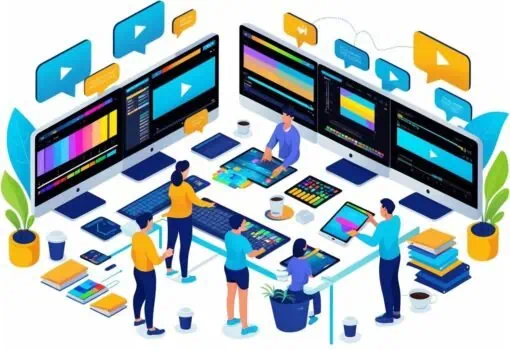Collaborative video editing lets you and your team work on the same project together, making it faster and easier to create high-quality videos. With new technology and cloud-based tools, you don’t have to be in the same room to make changes or share ideas. Now, you can edit, comment, and organize tasks as a group, even if everyone is in a different place.
Many platforms, such as Ltx studio, help you use smart tools like AI to speed up your editing process. This is great for streamlining your workflow and giving everyone a chance to add their creative touch. Working as a team makes your stories better and your projects stay on track.
Key Takeaways
- Collaborative editing speeds up teamwork on video projects
- AI tools help make video editing and sharing easier
- Platforms like LTX Studio improve content quality and workflow

Essentials of Collaborative Video Editing
Effective collaborative video editing depends on both reliable technology and good communication. Teams need powerful tools to share projects, give feedback, and make changes from different locations.
Core Features and Functionality
Collaborative video editing software lets you work together on projects in real time or asynchronously. Real-Time Collaboration allows several editors to edit, review, and comment on the same timeline at the same time. You can track changes, see who made edits, and quickly resolve conflicts.
AI Video Editing Software can help automate repetitive tasks, like cutting scenes or syncing audio. Many platforms let you manage permissions, so you control who can view or change specific parts of a project.
Typical features include:
- Shared project libraries
- Version history and rollbacks
- Task assignment and progress tracking
- Integrated chat or comment systems
These tools improve workflow by letting you and your team work efficiently, despite being in different places or time zones.
Benefits for Modern Content Creators
With collaborative editing, you save time and reduce errors. Content Creation Automation through AI speeds up tasks such as auto-tagging clips, suggesting edits, or creating subtitles. This means you can focus more on creative decisions.
Your team can respond quickly to feedback without having to send project files back and forth. Cloud-based platforms make it easy to access your work from anywhere and on different devices.
For fast-paced projects or remote teams, collaborative video editing brings flexibility, better organization, and a smoother process. This way, you deliver quality content faster and with better teamwork.
AI-Powered Tools in Video Collaboration
New advances in video editing rely on artificial intelligence to help make creative work faster and easier. Modern software now lets you use AI to automate editing, create storyboards from written scripts, and develop dynamic video content with less manual effort.
Generative AI Technology for Video Editing
Generative AI technology has changed how you can approach video production. With these tools, you can automatically generate video clips, transitions, and effects that match your creative goals. This means you spend less time on basic tasks and more on making creative choices.
Some AI content creation platforms use machine learning to suggest visuals, music, or edits. These suggestions are based on your project style, script, or even audience preferences. AI video editing software can also propose alternative versions of the same clip, giving you more options to explore.
You can use creative AI solutions to quickly assemble rough cuts, choose theme-appropriate music, or even generate graphics from just a simple prompt. These technologies are designed to work with your existing workflow, making collaborative video editing more efficient and accessible.
Automated Editing Techniques
Automated editing uses artificial intelligence to handle repetitive and time-consuming video editing tasks. When you import footage into an AI-powered platform, the software can automatically select highlights, cut awkward pauses, and sync audio with video.
Lists of typical automated editing features include:
- Scene detection
- Auto color correction
- Audio enhancement
- Automated subtitles
With these features, you spend less time on technical details and can focus on storytelling and content quality. Many collaborative editing tools now let team members review, adjust, or accept AI-suggested edits together, making teamwork faster and more organized.
Script-to-Storyboard Conversion
Script-to-storyboard conversion uses AI to transform your written script into a visual plan. AI storyboard generators read your script, identify scenes and actions, and generate illustrated boards for each part.
This process helps your team visualize the finished video before any filming or animation starts. Key benefits for you include:
- Saving time on manual drawing or design
- Creating fast drafts for team feedback
- Improving communication among writers, directors, and editors
Many AI video production tools let you edit or rearrange storyboard frames, so you can experiment with different story flows. Having a visual roadmap makes it easier for your team to stay on track during production.
AI-Driven Storytelling Tools
AI-driven storytelling tools help you create better stories by analyzing your video, script, and project data. These tools can suggest scene changes, add narrative elements, and recommend visual or audio enhancements that fit the mood of your film.
For example, some platforms use AI to analyze emotional tone, pacing, or theme continuity. If your story is missing key elements, the software can suggest dialogue or visuals to fill the gaps. With an AI content creation platform, your team can quickly test different story versions and gather feedback in real time.
Collaborative environments benefit from these tools because all team members can interact with story suggestions, comment, and make changes together. This helps create balanced, high-quality video content in less time.

Enhancing Visual Storytelling Through Collaboration
Collaborative video editing gives you access to real-time input, shared resources, and a wider range of creative ideas. Working together, you can use innovative tools and techniques to improve the quality, speed, and impact of your storytelling.
Advanced Filmmaking Tools
Modern visual storytelling tools help your team work together easily, even if you are in different places. Shared project files make it simple for each person to add footage, edit scenes, or adjust colors without overwriting others’ work.
Key Features of Collaborative Tools:
| Feature | Benefit |
| Shared timelines | Real-time editing by multiple people |
| Cloud storage | Easy access to media and project files |
| Version control | Track changes and restore edits |
Using these tools, you can divide tasks, such as sound mixing or visual effects, so each member works on their strength. Communication tools, like comments or chat built into platforms, also help clarify ideas and avoid mistakes.
AI-Powered Visual Storytelling
AI tools are changing how you tell stories in video projects. You can use artificial intelligence to automate boring tasks, such as cutting dead space, syncing audio, or color grading.
AI is also helpful for sorting large amounts of raw footage. It can quickly find the best takes or recommended scenes based on your goals.
Benefits of AI in Editing:
- Faster editing with smart automation
- Improved accuracy when choosing clips
- Easier scene transitions and visual effects
By using AI-powered tools, your team spends less time on repetitive tasks and more time focusing on creative ideas.
Creative Integration in Narrative Creation
Collaboration allows for richer narrative creation because each person brings their own point of view and expertise. You might work with writers, directors, and editors in one project, sharing feedback and shaping the story together.
AI can also help in narrative creation by suggesting story structures or dialogue. When everyone shares ideas and uses advanced tools, your video’s story becomes more interesting and clear.
A mix of human imagination and technical support means your final product is more engaging and meaningful. This process turns group ideas into a clear and compelling visual story that holds the viewer’s attention.
Customizing Content with AI in Collaborative Environments
AI makes it easier to create and personalize videos with your team. These tools can help you quickly generate characters, edit scenes, and make content that fits your goals.
Character Customization and Generation
AI character generators let you create unique people and avatars for your videos. You can pick features like hair color, face shapes, clothing, and even voice. This is helpful when you want your content to stand out or represent specific audiences.
You and your team can easily make changes to these characters as you collaborate. AI tools can also automatically generate background characters or extras, saving you time. Some tools let you upload photos or sketches for more control. You can preview changes in real-time and get different style options fast.
| Feature | Benefit |
| Custom Face & Body Shapes | Matches your creative needs |
| Automated Character Roles | Speeds up background generation |
| Voice Customization | Gives characters unique voices |
Good AI content creation platforms offer templates and suggestions to improve your designs. This helps create a consistent style across your team’s videos.
AI Filmmaking Platforms for Teams
AI filmmaking platforms let teams work together on editing, storytelling, and production. You can share video files, edit scenes, and add effects at the same time. Edits made by one person update for the whole group right away.
These platforms use AI to provide smart editing tools, like automatic scene transitions or voice syncing. They suggest improvements based on your script or footage. Many offer drag-and-drop features, making it simple for everyone to join in.
Some popular platforms* use cloud storage so you and your team can access projects from anywhere. They also track every change, making it easy to see who edited what, and help avoid mistakes.
*Examples: RunwayML, Descript, or Lumen5. These tools work well for teams, letting you focus on creative decisions while the AI handles technical parts.
Streamlining Project Workflow and Delivery
Efficient workflows and delivery are crucial for successful collaborative video editing. Using the right technological tools can support organization, speed, and team coordination at every stage of the project.
AI Pitch Deck and Presentation Tools
AI-powered platforms can help you create clear, engaging pitch decks for your video projects. AI Pitch Deck Generators use project data and video content to produce visual slides, infographics, and summaries. This helps communicate your ideas faster and more clearly to partners or clients.
Integrating an AI Content Creation Platform lets you auto-generate text, visuals, and even storyboard suggestions. Tools like these reduce the time spent on manual design, letting you focus on creative editing.
Table: Examples of Useful AI Solutions
| Tool | Main Feature | Benefit |
| AI Pitch Deck Generator | Auto-Makes Decks & Slides | Faster, Clearer Presentations |
| AI Content Creation Platform | Writes, Designs, Suggests | Quick Content Producing |
| Creative AI Solutions | Custom Visuals, Graphics | More Dynamic Project Outputs |
By using these creative AI solutions, you improve project communication and speed up the start of every video workflow.
Managing Collaborative Workflows
Managing collaborative workflows in video editing means keeping tasks, files, and feedback organized for all team members. Many teams use shared calendars, project boards (like Trello or Jira), and cloud storage to schedule editing tasks and track progress.
Online collaboration tools help everyone see updates instantly. You can tag tasks, leave comments, and adjust schedules in real time. This cuts down on confusion and keeps your team in sync.
Setting clear roles and deadlines is key. Assign specific editing tasks, revisions, or video review steps to each person. This ensures work moves forward smoothly and avoids delays.
Communication efficiency grows when teams use messaging apps and editing software that allow direct feedback on video drafts. With good workflow management, you deliver edited videos faster and with fewer errors.
Frequently Asked Questions
Collaborative video editing lets you and your team work on the same video project at the same time from different locations. Using the right tools and following good teamwork practices makes editing smoother and more efficient.
What are the leading software options for collaborative video editing?
Some of the most popular options include Adobe Premiere Pro with Team Projects, Final Cut Pro with shared libraries, and DaVinci Resolve with Project Server. Online tools like Frame.io also offer strong collaboration features for reviewing and giving feedback.
Are there any free collaborative video editing tools available?
Yes, some free tools let teams edit videos together. Kapwing and WeVideo offer basic free plans with online collaboration. Clipchamp also has a free version for simple projects, but advanced features may need a paid plan. Always check the provider’s terms for limits on exports or storage.
How do multiple users simultaneously edit video projects remotely?
Most collaborative editing tools use cloud storage or project sharing to sync changes in real time. Some platforms let you lock clips or sequences to prevent overlap. You and your teammates can work on different parts of a project at once, then merge changes as you go.
Which collaborative video editing platforms integrate with CapCut?
CapCut mainly supports projects within its platform, but you can export projects for sharing. As of now, it does not offer direct integration with third-party collaborative platforms. For team projects, all editing usually needs to happen within CapCut itself, or via exported file sharing.
Which online video editing tools allow for real-time team collaboration?
Frame.io, WeVideo, and Kapwing allow several users to work on a project at the same time. Canva also includes real-time video editing for teams. These tools support live commenting, shared timelines, and instant updates across devices.
What are the best practices for managing collaborative video editing projects?
Assign clear roles and responsibilities at the start so everyone knows their tasks. Use version control to keep track of changes and avoid mistakes. Schedule regular review sessions, and use shared folders or cloud storage for organized project files. Good communication is key to staying updated on progress and changes.

